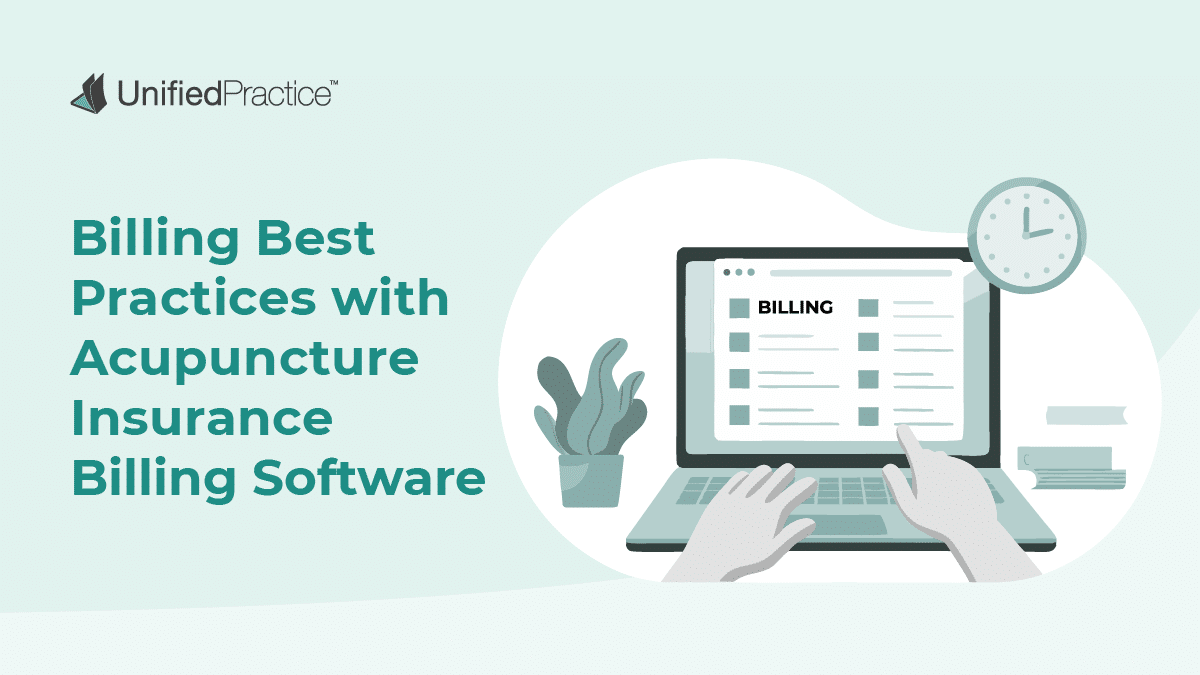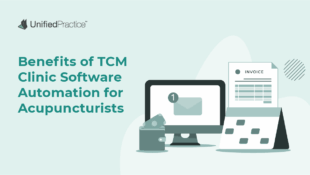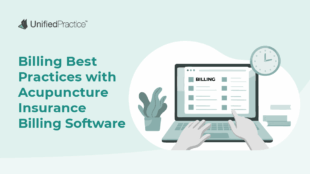If you have ever felt lost in the world of acupuncture billing, you are not alone. Coding can be confusing, insurance rules change constantly, and claims often take too long to get reimbursed. For a small practice, that can mean late payments, cash flow problems, and too much time spent on paperwork.
With Unified Practice, you don’t have to carry that stress. It is an all-in-one acupuncture practice management platform that helps you bill correctly, get reimbursed on time, and cut down on administrative headaches.
This article will walk you through the best practices for acupuncture billing and show you how acupuncture insurance billing software can make each step easier.
Table of Contents
- Why Billing Best Practices Matter in Acupuncture
- What are the Best Practices for Acupuncture Billing?
- What Role Does Acupuncture Insurance Billing Software Play in Streamlining Claims?
- Streamline Billing with Unified Practice
- Frequently Asked Questions
Why Billing Best Practices Matter in Acupuncture
Billing may not be glamorous, but it is the backbone of your financial health. Accurate, consistent billing ensures that you are reimbursed for the services you provide and protects your practice from unnecessary financial stress.
When billing is not managed well, the impact shows up quickly:
- Cash flow issues: Delayed or denied claims mean money you earned is sitting on hold. This can make it hard to cover operating expenses, pay staff, or invest in your practice.
- Burnout and frustration: Spending hours reworking claims or calling insurers takes valuable energy away from patient care.
- Compliance risks: Inaccurate coding or missing documentation can result in penalties or even payer audits.
This is why strong billing practices give peace of mind. They create predictable income, reduce denials, and let your staff focus on patients instead of chasing payments. Patients also benefit when bills are accurate, transparent, and easy to understand.
What are the Best Practices for Acupuncture Billing?
Acupuncture billing is uniquely challenging because there is no single, universal standard across insurers. One payer may cover acupuncture for pain management, while another covers only a handful of conditions. Without a clear system in place, it is easy to make mistakes that delay or reduce reimbursement.
To counter this, here are four best practices every acupuncture clinic should follow.
1. Know the Core CPT Codes
Acupuncture services are billed primarily with four CPT codes: 97810, 97811, 97813, and 97814. These codes describe whether acupuncture is performed with or without electrical stimulation, and whether it is the initial treatment or an add-on for additional time.
Best Practice: Document start and stop times, bill only for direct face-to-face patient care, and apply add-on codes only when they are truly appropriate. In addition, leverage United Practice software to avoid having to memorize codes or worrying about errors. This software automatically applies the right codes based on your notes, ensuring accuracy and consistency.
2. Understand Insurance Requirements and Coverage Limits
Not all insurance plans cover acupuncture in the same way. Some plans reimburse only for specific conditions such as migraines or back pain, while others limit the number of visits per year. A patient may assume they have coverage, only to find out later that their plan excludes acupuncture or reimburses at a very low rate.
Best Practice: Verify a patient’s benefits before the first treatment begins. Always confirm whether acupuncture is covered, which conditions qualify, and how many visits are allowed. Track sessions carefully to avoid billing beyond the coverage limit, which often results in denials.
Unified Practice allows you to track patient billing history, monitor coverage limits, and manage payment plans or discounts if a patient wants to continue care beyond what their plan covers. Learn More.
3. Stay Current with State and Insurance Regulations
Insurance policies and state regulations can shift quickly. What was billable last year may no longer be today. For example, some states are expanding Medicaid coverage for acupuncture, while others still exclude it. Private payers also adjust their coverage rules frequently.
Best Practice: Assign someone in your practice to monitor policy updates and train your team on any changes. Consider creating a simple “billing updates log” that everyone can reference so the entire staff stays on the same page. Take it a step further with United Practice’s centralized billing tools. Forms, codes, and documentation are easy to update across your system, so you can adapt without overhauling your entire process.
4. Maintain Consistency Across the Practice
Billing is most effective when it is handled the same way by everyone on your team. If one staff member uses one template and another uses a different method, errors and delays are inevitable. Consistency creates efficiency.
Best Practice: Standardize your billing forms, templates, and workflows. Create clear procedures for how to handle invoices, superbills, and insurance forms. By keeping everything in one place with Unified Practice (invoices, superbills, CMS 1500 forms, and payment processing), billing stays consistent no matter who is working at the front desk.
What Role Does Acupuncture Insurance Billing Software Play in Streamlining Claims?
Submitting and tracking insurance claims is one of the biggest pain points in acupuncture billing. Manual processes often mean typing the same information multiple times, mailing forms, chasing claim statuses, and resubmitting denials. Each mistake adds days or even weeks to your reimbursement timeline.
Acupuncture insurance billing software eliminates much of that friction. Instead of piecing together spreadsheets, forms, and sticky notes, you get one central system that manages claims from start to finish.
With Unified Practice you can:
- Submit claims electronically: No more printing or mailing forms. Electronic submission ensures payers receive your claims immediately and reduces the chance of missing information.
- Auto-populate claim forms: Unified Practice generates CMS-1500 forms with the correct patient, provider, and coding information pulled directly from your chart notes. This minimizes errors that typically cause denials.
- Track claims in real time: Instead of waiting weeks to learn if a claim was accepted, you can see its status inside your dashboard. If a payer requests clarification or denies a claim, you know right away and can act quickly.
- Handle resubmissions with ease: Resubmitting a claim no longer requires starting from scratch. You can update the information, correct errors, and resubmit with just a few clicks.
- Simplify collections and posting: Payments from insurers or patients are automatically matched with outstanding claims, making it easier to see what is paid, pending, or overdue.
The result is not just saved time, but a more predictable revenue stream.
Streamline Billing with Unified Practice
The truth is, unclear processes and scattered tools are often the biggest barriers to efficiency. If you are relying on paper superbills, manual coding, or disconnected payment systems, it is easy to make mistakes and harder to stay organized.
Unified Practice brings everything under one roof so you can manage billing with clarity and consistency. From verifying insurance and generating accurate codes to submitting claims electronically, tracking payments, and offering flexible patient billing, every step is simpler and more reliable.
Explore Unified Practice’s billing features to see how acupuncture insurance billing software can simplify your billing, support your growth, and give you confidence that you are getting paid for the care you provide.
Frequently Asked Questions
How does acupuncture insurance billing software help reduce errors?
Unified Practice generates invoices, superbills, and CMS-1500 forms, so you don’t have to retype information or worry about common manual mistakes.
Can Unified Practice simplify patient billing?
Yes. You can set up discounts, packages, promotions, and payment plans, making billing more flexible and transparent for patients.
How does Unified Practice support claims management?
It produces CMS-1500 forms for insurance submissions and tracks billing activity within one platform.
What role does UnifiedPay play in billing?
UnifiedPay securely processes payments, stores cards on file, and allows practices to manage no-show fees or remote transactions.




